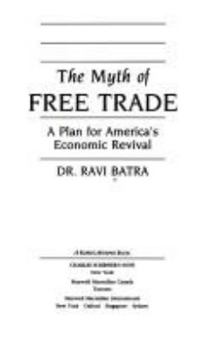The Myth of Free Trade: A Plan for America's Economic Revival
The author of The Great Depression of 1990 argues that America's failure to keep an eye on its competitors and limit foreign imports has spelled disaster and he sets out a five-year plan for recovery. This description may be from another edition of this product.
Format:Hardcover
Language:English
ISBN:0684195925
ISBN13:9780684195926
Release Date:January 1993
Publisher:Scribner Book Company
Length:274 Pages
Weight:1.27 lbs.
Dimensions:1.1" x 6.4" x 9.6"
Related Subjects
Accounting & Finance Business Business & Investing Economics International Popular EconomicsCustomer Reviews
1 rating
Lessons in Economic History
Published by Thriftbooks.com User , 17 years ago
The Myth of Free Trade, by Ravi Batra The 'Introduction' explains the effects of "free trade" policies on falling real wages, lost jobs, and environmental destruction (p.3). Prosperity comes from manufacturing, not services of agriculture. Both Democrats and Republicans have stood idly by, Trade liberalization has enriched the American elite and impoverished most Americans by falling real wages. This can be reversed by higher tariffs (protectionism) but only if businesses are forced to compete via anti-trust laws (p.5). Wages, productivity, and real incomes would increase, and deficits and energy prices would drop when tariff rates are increased. This would reverse the economic decline since 1973. Ten reasons are given to explain falling productivity (pp.12-15). Batra says they are incorrect and misleading. Economic statistics are extremely misleading when inequality is growing (p.23). Real wages show the true picture (pp.24-25). Page 30 shows this impoverishment. Poverty, both absolute and relative, has increased since 1973 (p.31); its a "silent depression" (p.34). The corporate media lies about the real facts. Chapter 3 links the low tariffs of "free trade" to the poor economy that followed. Productivity rose and real wages fell (p.47) because of the break in the links (p.51). This is explained on pages 56-57. Huge government subsidies to agriculture caused falling farm earnings (p.63). Falling industrial prices since 1973 ended millions of manufacturing jobs (p.67). This is by design, not accident (p.71). De-industrialization is explained on pages 72-73. Free trade alone caused slower productivity and reduced real earnings (p.84). The enormous domestic competition in Japan resulted in superb goods at low prices. Taiwan's domestic rivalry created prosperity (p.111). Monopolies hinder economic development (p.122). Australia's real earnings stagnated after tariffs were cut (p.125). Chapter 7 is a history of tariffs in America. The Embargo Act of 1807 created domestic manufacturing (p.131). This new class of manufacturers was opposed by shipping interests and Southern planters. High tariffs before the Civil War produced more industrial output, declining consumer prices, and great technical innovation (p.133). Later this created "the preeminent economic power in the world" (p.135). The multitude of small businesses competed (p.137). But the economic recessions and depressions resulted in fewer and larger firms. The lower tariffs of "free trade" was to allow corporations greater access to foreign markets. Chapter 8 discusses the bias towards "free trade". The charts on pages 151-152 show a relationship of unemployment rates to the tariffs (a fall then a rise). "Free trade" works to make the wealthy richer but most people poorer. Frequent mergers and acquisitions enabled some companies to a captive domestic market. Domestic competition doesn't harm workers like foreign competition (p.167). Chapter 10 summarizes the preceding chapters. Batra predi




